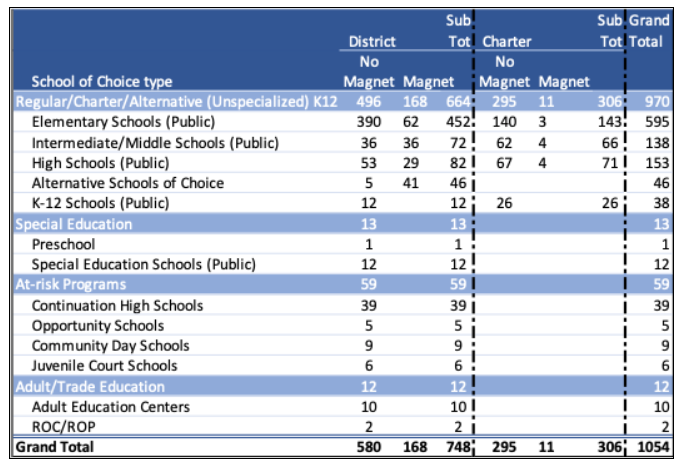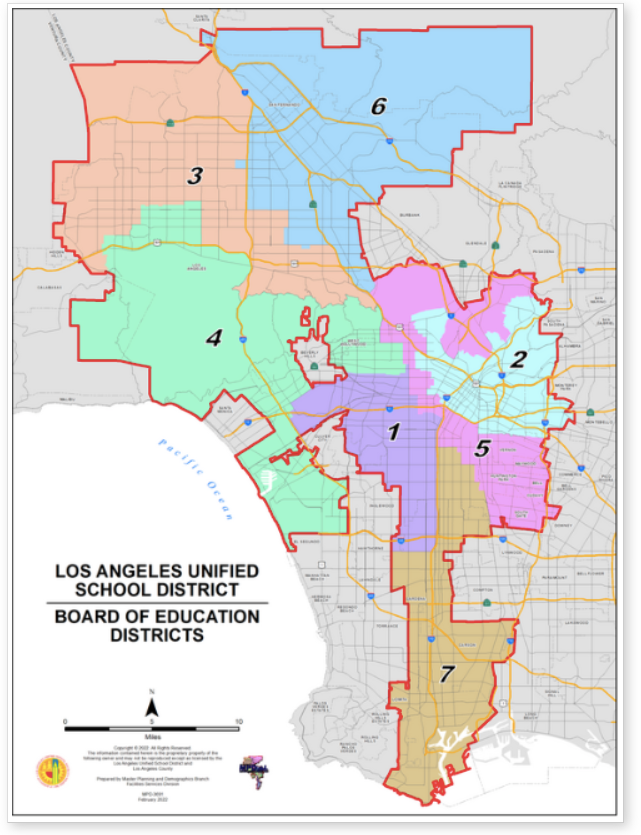CommentsEDUCATION WATCH - Poverty has increased in LAUSD post-covid. And in two board districts the late Eli Broad’s plan to transfer half of LAUSD into “charter school seats” is nearly fulfilled.
Demographics about the 2018-19 LAUSD school year immediately prior to the Covid-19 pandemic were published in June 2019 here. Following are comparable charts, graphs and statistics for 2020-21, the LAUSD school year following the covid closure of March 13, 2020.
The original text, charts, graphs, figures and statistics may provide useful context, so side-by-side comparison with the 2019 article is likely necessary for a better narrative flow.
Alternative Schools Of Choice have supplanted regular elementary, middle and high schools
During the two years preceding the pandemic, the number of intermediate and high schools each dropped by 8% (n=12 and 13) overall (table 1). For high schools the loss was evenly distributed among magnet and non-magnet, and more magnet-heavy for middle schools. District high schools dropped 15% (n=14). There were ten net new charters, mostly elementary.

Table 1: Distribution of schools by “Choice” status, and whether charter or magnet school, in LAUSD and Los Angeles County, 2020-21.
The notable change is that LAUSD opened twice the “Alternative Schools of Choice”, mostly magnet schools, as well as six additional magnet schools classified among regular elementary schools. As “Schools of Choice” with additional federal funding, magnet schools originated as integration tools with a strong curricular focus. Magnets have been heralded as a stop-gap to halt the flow of students from district public schools to privatized charter schools.
Whether superficial rebranding, substantive alternative or bookkeeping restructure, overall numbers might not necessarily reflect meaningful shifting of school-“type”; statistics do not show whether these serve essentially similar communities.
Most of the increase in charter schools (CS) comes at the county level where elementary CS more than doubled (table 2). Nearly 30% of the schools in LAUSD’s footprint are charter schools (306/1054). The County has authorized an additional 30% more schools (36 up from 26) in just two years.

Table 2: Distribution of charter and district school authorizers locally and through the state, 2020-21.
The incentive of school’s academic or management oversight is belied when a superseding authority is mandated to issue a charter denied at the subordinate level. The nested oversight of local -> County -> State provides a regulatory workaround for confidence lost.
And “charter market share” gained has not even been calculated here (table 4below) from among these work-around authorizers. Strictly the “pure” calculation from within-LAUSD alone has been used in reckoning progress on the Broad plan of charter transformation (figure 2 below).
Geographic distribution
While the LAUSD has been politically redistricted in 2021 (figure 1), these data are categorized according to the old district map, with its severe SE-NE gerrymandering. That gerrymander remains, with connecting landbridge simply flipped westward to incorporate, and divide, Asian communities.

Figure 1: 2021 Redistricting of LAUSD’s political boundaries. The previous decade’s political gerrymandering of its eastern section remains, dividing Asian communities and parsing the Latino. The northeast Valley is artificially conjoined with its urban westside, south of the Santa Monica mountains wilderness area. This new redistricting is presented for political context; all data here are analyzed according to the previous decade’s political boundaries which were in effect at the time of these counts.
The geographic concentration of charter schools among board districts is not appreciably changed by the influx of County-authorized charters (table 3); the distribution is largely unchanged. The Hispanic, unincorporated sections of LAUSD’s eastward footprint (LAUSD2) retain approximately twice the total number of charter schools as the district with the least number of these (LAUSD7). Though the County-authorized schools are largely absent from the two most wealthy districts, LAUSD3/4.
(Sara Roos is a politically active resident of Mar Vista, a biostatistician, the parent of two teenaged LAUSD students and a CityWatch contributor, who blogs at redqueeninla.com.)
















